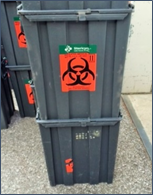print version of this document
Who to contact for assistance for biowaste picked up by Stericycle:
Contact Stericycle Customer Services if/when:
- pickup frequency needs to be changed
- extra containers are needed for the next pickup
- waste is not picked up during regularly scheduled pickup day
Call 866-338-5120 (be prepared to provide your account and group #).
Contact OCRS Biosafety if/when:
- advice/assistance is needed regarding how to collect and dispose of any biohazardous waste
- training questions related to regulated medical waste
- spills or exposures involving biowaste or biological materials
Call 615-322-2057.
Contact your department’s designated representative if/when:
- service-related issues arise that are not being effectively addressed through communications with Stericycle Customer Service
- Account and group # information is needed (this should have been communicated to each lab already, but can be provided again if needed)
- A new lab or pickup location needs to be added to the account.
Stericycle Account Contact for Engineering Departments:
Tana Hoffman
615-343-7860
Tip 1: Disposal of tissues and carcasses
Remember that animal or human tissues/organs (other than incidental residues) used in research or teaching should not be disposed of in your lab Stericycle container. Alternatives for disposal include:
- Animal tissues/organs from animals used on animal protocols can be disposed of through the Division of Animal Care (DAC) animal holding facility of origin.
- Unused human tissue obtained through a clinical area should be returned to that clinical source if at all possible.
- Contact OCRS Biosafety (biosafety@vumc.org, 615-322-2057) for coordination of disposal of animal tissues/organs obtained from markets or slaughterhouses, or for assistance with any tissue waste disposal need not specifically addressed here.
TIP 2: Acceptance criteria for incoming Stericycle containers

Your Stericycle driver should be providing you with the rectangular gray model of shipping container shown here. Assure that all containers are in good condition before accepting them. If you see any of the following conditions, request a new container:
- Lid flaps held on by only one hinge
- Containers with cracks down the side
- Containers lacking the snap-on closures on the lid
NOTE: Stericycle should NOT be delivering cardboard containers!
TIP 3: Storage of waste in excess of the Stericyle container’s capacity
If you generate more waste than your Stericycle container can hold, sealed biohazard bags can be temporarily stored in the lab. NOTE: Assure that you collect waste in bags that will fit inside Stericycle container. Tie full bags closed and store them in a leak-proof secondary container, such as an autoclave tray. Contact Stericycle Customer Service to request that extra containers be brought at your next pick-up. Note that you will need to provide your account and group # when making the call. If you don’t know this information, contact your department’s designated account contact (see contact numbers below) for assistance.
TIP 4: Liquids in Stericycle
Free-flowing liquids or containers of bulk liquids should not be placed in Stericycle containers. Bulk liquids should be treated with disinfectant and disposed of via the sanitary sewer as outlined in the OCRS Biohazardous Waste Disposal Guide. Lab process containers (i.e., cell culture flasks, sample tubes) that contain residual liquids are acceptable for Stericycle disposal, but containers should be closed before placement in the Stericycle container.
TIP 5: Posting of contact Information for authorized signers
Stericycle must collect a signature on the “shipping paper” before they can remove the waste. Only personnel who have successfully completed DOT training for regulated medical waste should be signing, but Stericycle is not required to verify the training status of the signer. To help address this potential noncompliance scenario, OCRS has prepared a sign template that can be completed with your lab’s information and posted in the area where the Stericycle containers are stored. Please make all lab personnel aware of the posting and its relevance. Whenever possible, plan to have a trained, authorized signer available in the lab during the regularly scheduled pickup time.